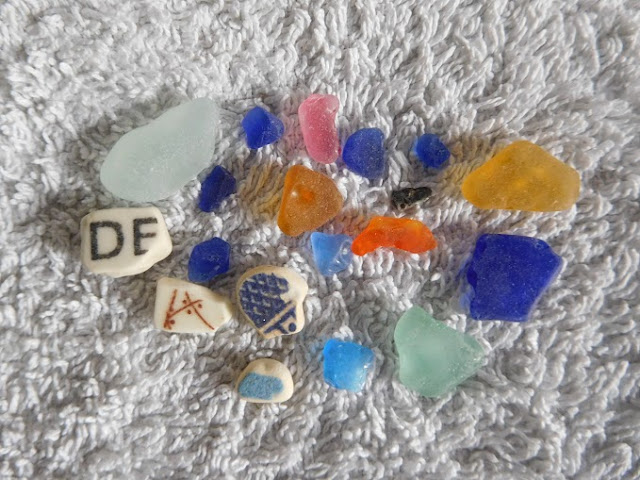I was feeling sad and I got out my jar of 'seaglass' from St. Ives in Cornwall;
I had five days there in 2009 and spent them clambering over hills and along cliffs.....until I ran out of energy on the last night.
So, I spent the next day at St. Ives looking at Art Galleries and shops, eating pasties and ice creams......basking in the sun.
Finally, I couldn't take another step. I ached and had blisters - it was time to go back.
Except I didn't want to.
I sat down on the beach near the high street, where a little stream ends at the sea after a long journey through the town.
I walked by the waters edge and saw a 'jewel' glistening in the sun.
It was seaglass - old, broken glass that has been weathered and shaped by the sea and the sand for years and years.
The funny thing is that at St. Ives harbour the waves are usually small, they just lap at the beach. You wouldn't think they could wear down glass.
Which means this seaglass is very old.
Some may have been there for a hundred years.
Obviously, the brown and the green comes from beer and wine bottles. The white is very ordinary too.
As you can see, I plundered King Neptunes treasure chest;
Here are some of the interesting ones;
Blue glass is fairly rare - the only modern source comes from 'Harveys Bristol Cream Bottles'. These fragments are too thin - they come from blue 'poison' bottles, dispensed by a pharmacist to patients with prescriptions who had to sign the 'poisons register'.
They date from any time up to the 1940's or 50's.
Sky blue is rare - in America it comes from very, very old Coke bottles, here I'm not so sure.
Orange and red? Unbelievably rare, I never saw any before.
There are four pieces of pottery - one is a dark blue willow pattern plate which you can still buy today but can also be old.
The white pottery with the plain, light blue glaze? That is very definitely 1960's.
The white pottery with light brown lines and dots seems quite old to me.
"DE" is probably from the 'Denby' pottery. I did a bit of detective work with the help of 'Pottery Histories', who have a very helpful website and this is what they told me;
From this I think that my 'DE' comes from a 1960's or 1970's plate or cup and probably from the same piece as the sky blue fragment. So I'm going for the 60's - it's very much a 1960's 'Denby' colour.
I parked free at the back of town and regretted it when I was walking back to my car, it hurt.
But I walked the length of the stream, which for part of the way passed along the front gardens of a long terrace of houses. It was quite rocky, steep and fast moving at this point.
Now I'm guessing that plenty of people in times past, feeling lazy, threw out a bottle or a broken cup into the stream at the front of their house. They heard it crack with a little guilty satisfaction and watched it disappear down stream, thinking nothing more of it.
But the stream broke the fragments down and smoothed off their rough edges in their long journey down to the harbour.
There a sandy beach and lapping waves did the rest over the long years.
Neil Harris
(a don't stop till you drop production)
Home: helpmesortoutstpeters.blogspot.com
Contact me: neilwithpromisestokeep@gmail.com




No comments:
Post a Comment